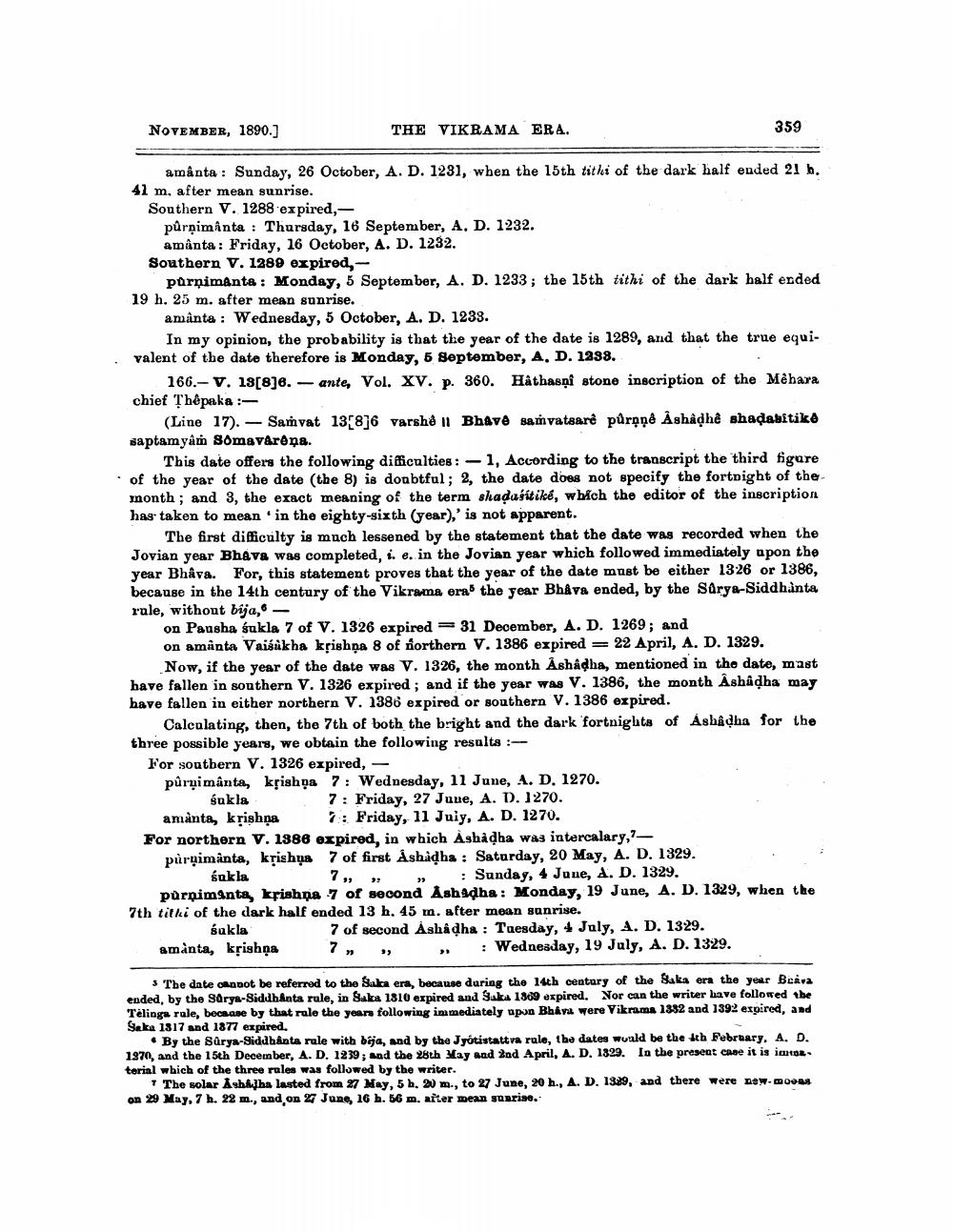________________
NOVEMBER, 1890.)
THE VIKRAMA ERA.
359
amânta: Sunday, 26 October, A. D. 1231, when the 15th tithi of the dark half ended 21 b. 41 m. after mean sunrise. Southern V. 1288 expired,
pûrņiminta : Thursday, 16 September, A, D. 1232. amânta: Friday, 16 October, A. D. 1232. Southern V. 1289 expired, -
pärnimanta : Monday, 5 September, A. D. 1233; the 15th tithi of the dark half erded 19 h. 25 m. after mean sunrise.
amânta : Wednesday, 5 October, A. D. 1233.
In my opinion, the probability is that the year of the date is 1289, and that the true equivalent of the date therefore is Monday, 5 September, A, D. 1998.
166.- V. 13[8]6. - ante, Vol. xv. p. 360. Háthasni stone inscription of the Mèbara chief Thêpaka :
(Line 17). - Saṁvat 13[8]6 varshë 11 Bhave samvatsaré půrone Ashảdhe shaçabitike saptamyam Somavaroņa.
This date offers the following difficulties: -1, According to the transcript the third figure · of the year of the date (the 8) is doubtful; 2, the date does not specify the fortnight of the month; and 3, the exact meaning of the term shadasítike, which the editor of the inscription has taken to mean in the eighty-sixth (year),' is not apparent.
The first difficulty is much lessened by the statement that the date was recorded when the Jovian year BhAva was completed, i. e. in the Jovian year which followed immediately upon the year Bhåva. For, this statement proves that the year of the date must be either 1326 or 1386, because in the 14th century of the Vikrama eras the year Bhåva ended, by the Sürya-Siddhinta rule, without bija, -
on Pausha sukla 7 of V. 1326 expired = 31 December, A.D. 1269; and on amanta Vaišukha krishna 8 of fiorthern V. 1386 expired = 22 April, A. D. 1329.
Now, if the year of the date was V. 1326, the month Åshadha, mentioned in the date, mast have fallen in southern V. 1326 expired; and if the year was V. 1386, the month Ashûdha may have fallen in either northern V. 1386 expired or southern V. 1386 expired.
Calculating, then, the 7th of both the bright and the dark fortnights of Ashâdha for the three possible years, we obtain the following results :For southern V. 1326 expired, - půrạimânta, krishọa 7: Wednesday, 11 June, A. D. 1270. sukla
7: Friday, 27 Juue, A. D. 1270. amanta, krishna 7: Friday, 11 Juiy, A. D. 1270. For northern V. 1886 expired, in which Ashảdha was intercalary, ?-- purgimânta, krishụs 7 of first Åshidha : Saturday, 20 May, A. D. 1329. sukla
7,, , : Sunday, 4 June, a. D. 1329. purnimente, krishna 7 of second Ashadha: Monday, 19 June, A. D. 1329, when the 7th titki of the dark half ended 13 h. 45 m. after mean sunrise. sakla
7 of second Ashadha : Tuesday, 4 July, A. D. 1329. amanta, krishna 7,
, : Wedneaday, 19 July, A. D. 1329.
3 The date onnot be referred to the Suka ere, because during the 14th century of the Baka era the your Beava ended, by the Sarya-Siddhanta rule, in Baka 1810 expired and Saka 1869 expired. Nor can the writer have followed the Telinga rale, became by that rule the youn following immediately upon Bhaya were Vikrama 1332 and 1392 expired, and Saka 1817 and 1877 expired.
By the Sürya-Siddhanta rule with boja, and by the Jyótistattva rule, the dates wuald be the th February. A. D. 1370, and the 15th December, A.D. 1239; and the 28th May and 2nd April, A. D. 1329. In the present case it is imte terial which of the three rales was followed by the writer.
+ The solar Åsbilha lasted from 27 May, 5 h. 20 m., to 27 June, 20 h., A. D. 1329, and there were new moves on 29 May, 7 h. 22 m., and on 24 June, 16 h. 66 m. aiter mean guarino.




